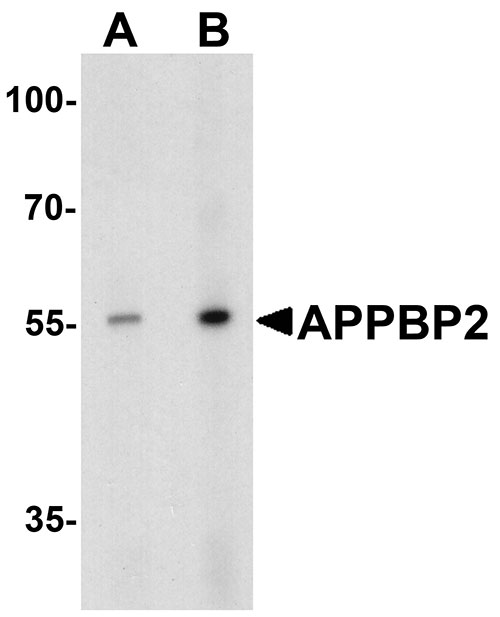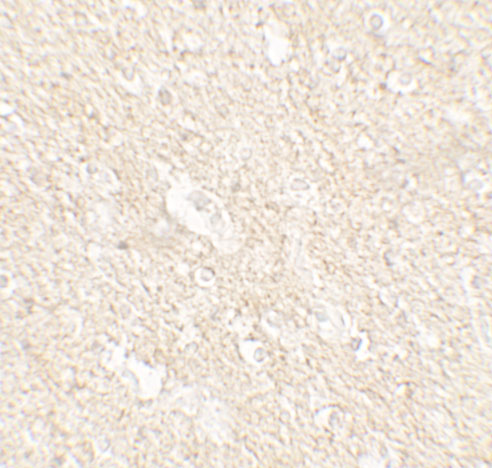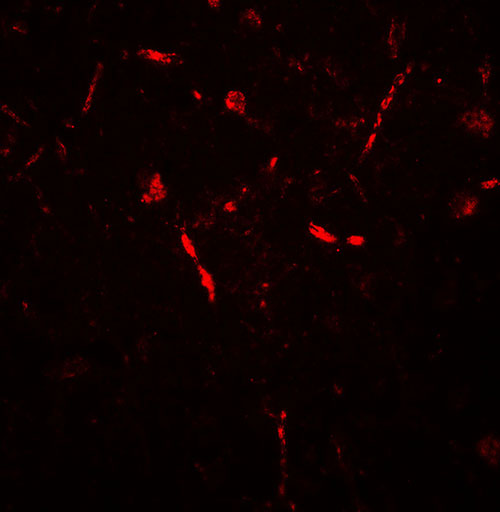APPBP2 Antibody
- SPECIFICATION
- CITATIONS
- PROTOCOLS
- BACKGROUND

Application
| WB, IHC-P, IF, E |
|---|---|
| Primary Accession | Q92624 |
| Other Accession | NP_006371, 18104962 |
| Reactivity | Human, Mouse, Rat |
| Host | Rabbit |
| Clonality | Polyclonal |
| Isotype | IgG |
| Calculated MW | Predicted: 64 kDa Observed: 57 kDa |
| Application Notes | APPBP2 antibody can be used for detection of APPBP2 by Western blot at 0.5 - 1 µg/ml. Antibody can also be used for Immunohistochemistry starting at 5 µg/mL. For immunofluorescence start at 20 µg/mL. |
| Gene ID | 10513 |
|---|---|
| Target/Specificity | APPBP2; APPBP2 antibody is human, mouse and rat reactive. At least two isoforms of APPBP2 are known to exist; this antibody will detect both isoforms. |
| Reconstitution & Storage | APPBP2 antibody can be stored at 4℃ for three months and -20℃, stable for up to one year. |
| Precautions | APPBP2 Antibody is for research use only and not for use in diagnostic or therapeutic procedures. |
| Name | APPBP2 {ECO:0000303|PubMed:26138980, ECO:0000312|HGNC:HGNC:622} |
|---|---|
| Function | Substrate-recognition component of a Cul2-RING (CRL2) E3 ubiquitin-protein ligase complex of the DesCEND (destruction via C-end degrons) pathway, which recognizes a C-degron located at the extreme C terminus of target proteins, leading to their ubiquitination and degradation (PubMed:29775578, PubMed:29779948). The C-degron recognized by the DesCEND pathway is usually a motif of less than ten residues and can be present in full-length proteins, truncated proteins or proteolytically cleaved forms (PubMed:29775578, PubMed:29779948). The CRL2(APPBP2) complex specifically recognizes proteins with a -Arg-Xaa- Xaa-Gly degron at the C-terminus, leading to their ubiquitination and degradation (PubMed:29775578, PubMed:29779948). The CRL2(APPBP2) complex mediates ubiquitination and degradation of truncated SELENOV selenoproteins produced by failed UGA/Sec decoding, which end with a -Arg-Xaa-Xaa-Gly degron (PubMed:26138980). May play a role in intracellular protein transport: may be involved in the translocation of APP along microtubules toward the cell surface (PubMed:9843960). |
| Cellular Location | Nucleus. Cytoplasm, cytoskeleton. Membrane; Peripheral membrane protein. Note=Associated with membranes and microtubules. |

Thousands of laboratories across the world have published research that depended on the performance of antibodies from Abcepta to advance their research. Check out links to articles that cite our products in major peer-reviewed journals, organized by research category.
info@abcepta.com, and receive a free "I Love Antibodies" mug.
Provided below are standard protocols that you may find useful for product applications.
Background
The amyloid beta precursor protein (cytoplasmic tail) binding protein 2 (APPBP2), also known as PAT1, interacts with microtubules and is functionally associated with beta-amyloid precursor protein transport and/or processing (1). The beta-amyloid precursor protein is a cell surface protein with signal-transducing properties, and it is thought to play a role in the pathogenesis of Alzheimer's disease (2). APPBP2 has been found to be highly expressed in breast cancer (3).
References
Zheng P, Eastman J, Vande Pol S, et al. PAT1, a microtubule-interacting protein, recognizes the basolateral sorting signal of amyloid precursor protein. Proc. Natl. Acad. Sci. USA 1994; 95:14745-50.
Selkoe DJ. Cell biology of the amyloid beta-protein precursor and the mechanism of Alzheimer's disease. Annu. Rev. Cell Biol. 1994; 10:373-403.
Li J, Yang Y, Peng Y, et al. Oncogenic properties of PPM1D located within a breast cancer amplification epicenter at 17q23. Nat. Genet. 2002; 31:133-4.
If you have used an Abcepta product and would like to share how it has performed, please click on the "Submit Review" button and provide the requested information. Our staff will examine and post your review and contact you if needed.
If you have any additional inquiries please email technical services at tech@abcepta.com.













 Foundational characteristics of cancer include proliferation, angiogenesis, migration, evasion of apoptosis, and cellular immortality. Find key markers for these cellular processes and antibodies to detect them.
Foundational characteristics of cancer include proliferation, angiogenesis, migration, evasion of apoptosis, and cellular immortality. Find key markers for these cellular processes and antibodies to detect them. The SUMOplot™ Analysis Program predicts and scores sumoylation sites in your protein. SUMOylation is a post-translational modification involved in various cellular processes, such as nuclear-cytosolic transport, transcriptional regulation, apoptosis, protein stability, response to stress, and progression through the cell cycle.
The SUMOplot™ Analysis Program predicts and scores sumoylation sites in your protein. SUMOylation is a post-translational modification involved in various cellular processes, such as nuclear-cytosolic transport, transcriptional regulation, apoptosis, protein stability, response to stress, and progression through the cell cycle. The Autophagy Receptor Motif Plotter predicts and scores autophagy receptor binding sites in your protein. Identifying proteins connected to this pathway is critical to understanding the role of autophagy in physiological as well as pathological processes such as development, differentiation, neurodegenerative diseases, stress, infection, and cancer.
The Autophagy Receptor Motif Plotter predicts and scores autophagy receptor binding sites in your protein. Identifying proteins connected to this pathway is critical to understanding the role of autophagy in physiological as well as pathological processes such as development, differentiation, neurodegenerative diseases, stress, infection, and cancer.




